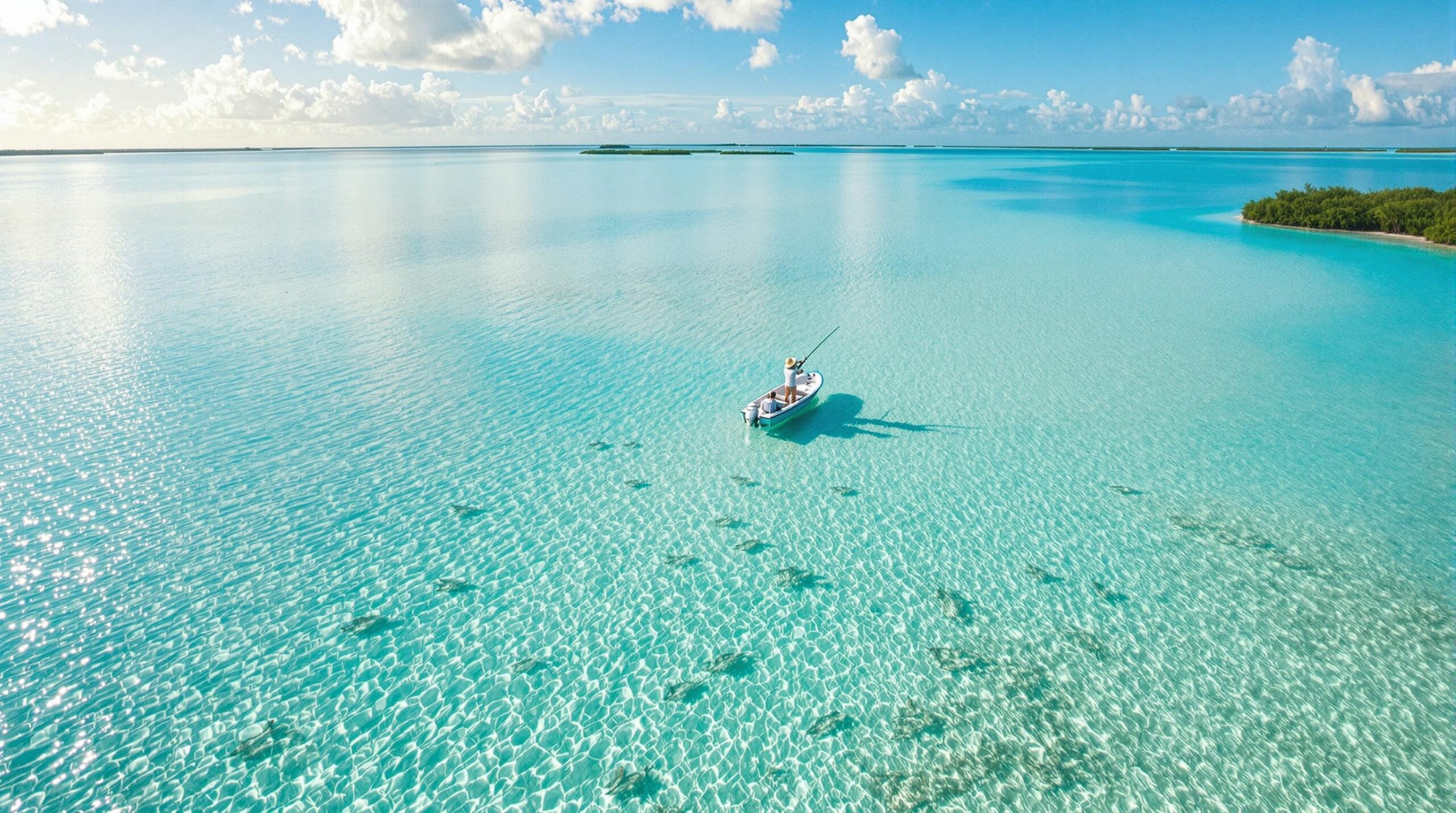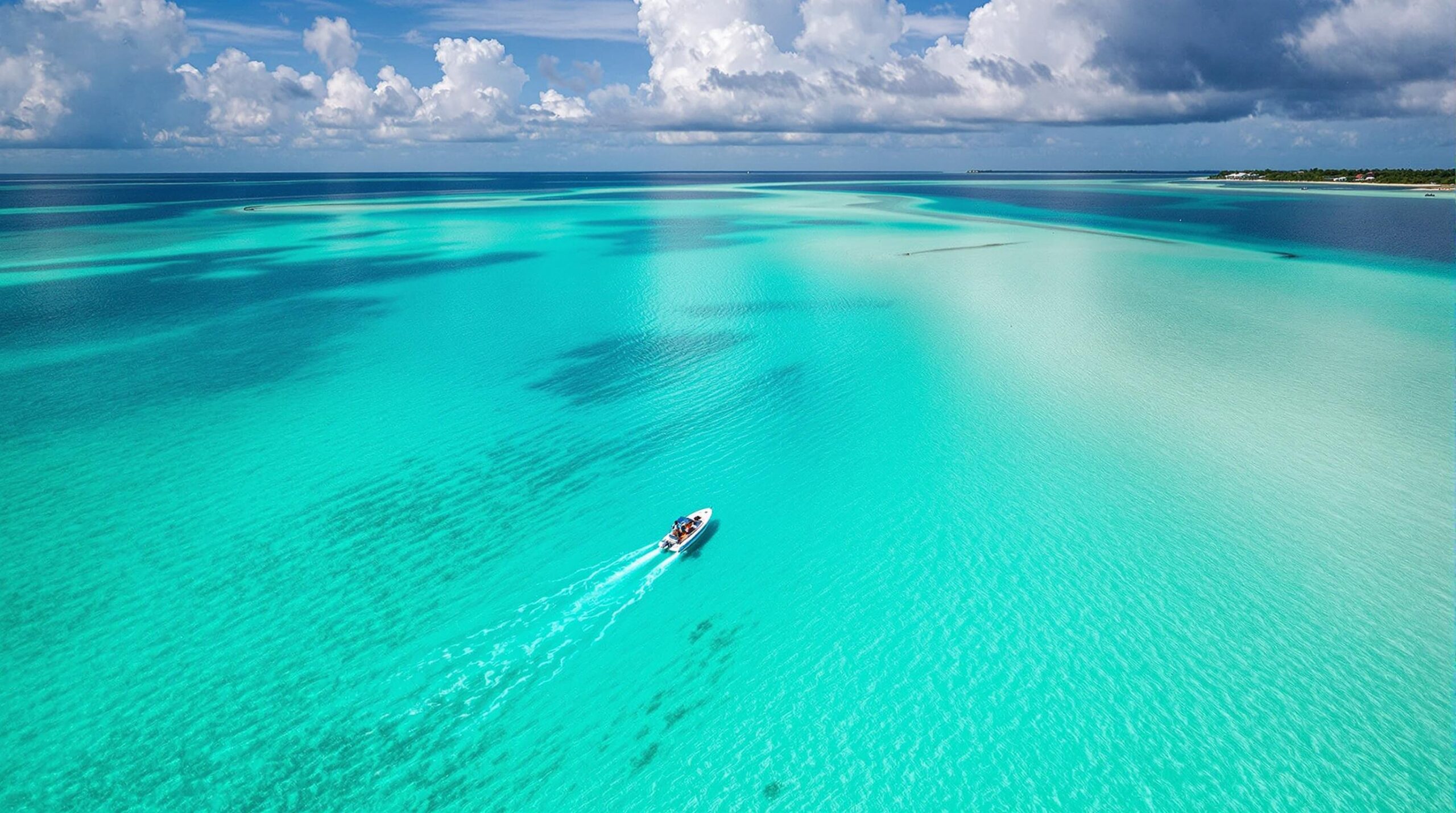According to Sport Fishing International, Ascension Bay ranks among the top three saltwater fly fishing destinations globally, with anglers experiencing 85% success rates for bonefish encounters during prime seasons. Timing your visit to this pristine Mexican flats destination can transform a good fishing trip into an unforgettable angling adventure.
Key Takeaways
- Prime season runs from November through April with calm weather and abundant bonefish activity
- Hurricane season from June through October poses weather risks but offers fewer crowds and lower prices
- Weather patterns directly impact fishing success, with cold fronts and wind being primary considerations
- Permit fishing peaks during warmer months while tarpon activity increases in summer
- Booking requirements demand 8-12 months advance notice for premium lodges during peak seasons
Prime Season: November Through April Delivers Peak Fishing
The cooler months provide Ascension Bay’s most reliable fishing conditions. Water temperatures hover between 75-80°F, creating ideal comfort zones for both fish and anglers.
Trade winds blow from the northeast at 10-15 mph during this period. These consistent conditions allow guides to position boats and provide anglers with manageable casting opportunities.
Bonefish activity reaches its annual peak from December through March. Schools of 20-50 fish become common sightings on the flats, with individual fish averaging 3-5 pounds.
Weather Advantages During Peak Season
Cold fronts, called “nortes” by locals, arrive every 7-10 days during winter months. These systems bring 2-3 days of challenging conditions followed by 4-5 days of superior fishing.
Morning temperatures start in the low 70s, warming to the mid-80s by afternoon. This temperature range keeps both fish and anglers comfortable throughout extended fishing days.
Rainfall averages just 2-3 inches per month from November through April. Clear skies enhance sight fishing opportunities, which form the foundation of successful flats fishing experiences.
Fish Behavior During Cool Months
Bonefish seek shallow, sun-warmed flats during cooler months. They feed aggressively in water depths of 12-18 inches, creating ideal sight fishing scenarios.
Schools concentrate on specific flats based on tide timing and water temperature. Local guides track these patterns daily, adjusting fishing locations to increase encounter rates.
Permit fishing remains productive during peak season, though cooler water temperatures make these fish more selective. Successful anglers need to present flies with increased precision.
Hurricane Season Considerations: June Through October
Hurricane season brings substantial weather risks to the Yucatan Peninsula. The National Hurricane Center reports that this region experiences an average of 2-3 tropical systems per year during peak hurricane months.
August and September present the highest storm probability. Many lodges close during these months or offer heavily discounted rates to reflect the weather uncertainties.
However, summer fishing can be outstanding when conditions align. Water temperatures in the mid-80s trigger increased fish activity, particularly for tarpon and permit species.
Summer Fishing Opportunities
Tarpon fishing peaks from June through August. These silver kings average 60-100 pounds in Ascension Bay, providing some of the most exciting fishing experiences available.
Permit become more active in warmer water. Summer months produce the year’s largest permit, with fish exceeding 20 pounds showing up on the flats.
Bonefish remain abundant during summer but change their behavior patterns. They feed in deeper water during the hottest parts of the day, requiring different fishing strategies.
Weather Challenges in Summer
Afternoon thunderstorms occur almost daily during summer months. These storms develop between 2-4 PM and can persist for several hours.
Humidity levels exceed 80%, creating challenging conditions for anglers unaccustomed to tropical climates. Proper hydration and sun protection become critical factors.
Mosquito and no-see-um populations peak during summer months. Strong insect repellent and protective clothing are essential for comfortable fishing experiences.
Peak Timing Within Prime Season
February and March represent the absolute peak of Ascension Bay’s fishing season. Water temperatures stabilize in the upper 70s, creating perfect conditions for aggressive fish behavior.
Cold fronts during these months bring 2-3 days of challenging conditions followed by 4-5 days of superior fishing. The post-frontal periods produce the trip’s most memorable fishing experiences.
Booking during this prime window requires advance planning. Premium lodges book these dates 12-18 months in advance, making early reservation essential.
Monthly Breakdown of Prime Season
November fishing can be outstanding but remains somewhat unpredictable. Late-season hurricane activity impacts early November, while consistent weather patterns establish by mid-month.
December offers reliable fishing with comfortable temperatures and minimal rainfall. Holiday bookings fill quickly, but fishing quality remains consistently high throughout the month.
January brings cooler temperatures and the season’s strongest cold fronts. While some days can be challenging, the post-frontal fishing produces extraordinary results.
Tide Timing Considerations
Falling tides produce the best fishing throughout peak season. Bonefish concentrate on specific flats as water levels drop, creating predictable feeding opportunities.
Morning tides provide the calmest conditions for sight fishing. Wind speeds remain lowest during early morning hours, improving casting accuracy and fish spotting.
Afternoon fishing can be productive during calm periods. However, increased wind speeds during afternoon hours can make sight fishing more challenging.
Shoulder Season Strategy: May and Late October
May represents an outstanding compromise between peak season reliability and off-season pricing. Water temperatures begin warming while hurricane activity remains minimal.
Late October can provide superior fishing as hurricane season winds down. Fish behavior intensifies as they prepare for the approaching winter months.
These shoulder months offer 20-30% savings on lodge rates while maintaining much of the peak season’s fishing quality. Availability also increases during these periods.
May Fishing Characteristics
Bonefish activity remains strong throughout May, with fish beginning to spread across a wider variety of flats. This dispersal can improve fishing for anglers willing to explore different areas.
Permit fishing peaks during May as water temperatures warm into the low 80s. These fish become more aggressive and less selective as metabolic rates increase.
Tarpon begin showing in greater numbers during May, providing opportunities for those interested in pursuing multiple species during a single trip.
Late October Opportunities
October’s cooling water temperatures trigger superior bonefish feeding activity. Fish school in large numbers as they prepare for winter months.
Weather patterns become more predictable in late October as hurricane season concludes. This reliability allows for better trip planning and reduces cancellation risks.
Lodge availability increases during October, making it easier to secure preferred dates and accommodations.
Weather Pattern Impact on Fishing Success
Understanding Ascension Bay’s weather patterns is crucial for fishing success. The region’s tropical climate creates distinct seasonal patterns that directly impact fish behavior and angling conditions.
Cold fronts during winter months bring the most dramatic weather changes. These systems approach from the northwest, creating 24-48 hours of challenging conditions followed by superior fishing.
Wind direction and speed impact fishing success. Consistent trade winds from the northeast create ideal conditions, while shifting winds can make certain flats unfishable.
Pre-Frontal Fishing Strategies
The 24-48 hours before a cold front’s arrival produce superior fishing. Barometric pressure changes trigger increased fish activity across all species.
Bonefish feeding activity intensifies during pre-frontal periods. Schools move into shallow water earlier than usual, creating extended feeding opportunities.
Permit behavior becomes more predictable during pre-frontal conditions. These fish feed more aggressively as they sense approaching weather changes.
Post-Frontal Recovery Periods
The 2-3 days following a cold front’s passage provide the trip’s best fishing. Water clarity improves dramatically, and fish resume normal feeding patterns.
Sight fishing conditions become ideal during post-frontal periods. Clear skies and calm waters create perfect scenarios for spotting and casting to individual fish.
Fish behavior becomes more aggressive during recovery periods. This increased activity can help compensate for any fishing time lost during the front’s passage.
Species-Specific Timing for Peak Success
Different species peak at varying times throughout Ascension Bay’s fishing season. Understanding these patterns helps anglers time their visits for specific target species.
Bonefish remain the most consistent species throughout the season, but their behavior patterns change based on water temperature and seasonal conditions.
Permit fishing varies dramatically by season, with summer months producing the largest fish while winter months offer more consistent numbers.
Bonefish Seasonal Patterns
December through March represents peak bonefish season. Water temperatures in the upper 70s create ideal conditions for aggressive feeding behavior.
Summer bonefish feed in deeper water during the hottest parts of the day. This behavioral shift requires different fishing strategies but can produce superior results.
Fall bonefish activity intensifies as fish prepare for winter. October and November produce some of the season’s largest individual fish.
Permit Fishing Strategies
May through August produces the largest permit of the season. Warmer water temperatures trigger increased activity in these prized fish.
Winter permit fishing requires more patience and precision. Cooler water temperatures make these fish more selective and less active.
Permit schools concentrate on specific flats during different seasons. Local guides track these patterns closely to increase encounter opportunities.
Tarpon Season Timing
June through August represents peak tarpon season in Ascension Bay. These months offer the most consistent opportunities for encountering these magnificent fish.
Tarpon fishing requires specific weather conditions to be successful. Calm mornings and evenings provide the best opportunities for sight fishing.
Late summer tarpon reach their peak size and activity levels. August produces the season’s most memorable tarpon encounters.
Booking Strategy for Premium Fishing Adventures
Securing reservations for Ascension Bay’s top lodges requires strategic planning and timing. Premium accommodations book 12-18 months in advance for peak season dates.
February and March dates book first, followed by December and January. These prime dates have waiting lists at the most sought-after lodges.
Flexible travelers can find superior deals during shoulder seasons. May and October offer substantial savings while maintaining high fishing quality.
Lodge Selection Considerations
Different lodges specialize in various fishing experiences. Some focus on bonefish, while others offer more comprehensive programs targeting multiple species.
Location within Ascension Bay impacts daily fishing opportunities. Lodges closer to prime flats reduce travel time and increase fishing hours.
Guide quality varies between operations. Researching guide experience and reputation helps ensure the best possible fishing experience.
Pricing Strategy Throughout the Season
Peak season rates run 40-60% higher than off-season pricing. This premium reflects both demand and ideal fishing conditions.
Shoulder season bookings include added value packages. These deals might include extra fishing days or upgraded accommodations at no additional cost.
Last-minute bookings during hurricane season can offer substantial savings but carry weather risks. These bookings work best for flexible travelers with alternative backup plans.
Travel Logistics and Timing
Getting to Ascension Bay requires careful coordination of international flights and local transportation. Most visitors fly into Cancun International Airport before transferring to local arrangements.
Ground transportation to departure points takes 2-3 hours depending on final destination. This travel time should be factored into trip planning.
Boat transfers to lodges can take 30-60 minutes depending on location and weather conditions. Rough weather can extend these transfers.
Flight Timing Considerations
Early morning arrivals in Cancun allow for same-day transfers to fishing lodges. This timing increases fishing time while reducing travel stress.
Late afternoon departures from Cancun provide flexibility for morning fishing on departure day. This schedule helps increase the overall fishing experience.
Weather delays can impact both international and domestic travel connections. Building buffer time into travel schedules helps manage these potential disruptions.
Equipment and Preparation Timeline
Gear preparation should begin 2-3 months before departure. This timeline allows for equipment testing, replacement, and backup planning.
Fly selection varies by season and target species. Planning your fly fishing trip requires understanding seasonal patterns and local preferences.
Physical conditioning becomes more important during summer months. Higher temperatures and humidity levels demand better fitness preparation.
Enhancing Your Ascension Bay Experience
Successful Ascension Bay trips require more than just good timing. Understanding local conditions, fish behavior, and fishing techniques impacts overall success.
Local knowledge proves invaluable for superior fishing opportunities. Guides who fish these waters daily understand subtle changes in conditions that can make or break a fishing day.
Flexibility in approach and expectations helps ensure trip success regardless of conditions. Weather and fish behavior can change rapidly, requiring adaptable strategies.
Essential Skills and Techniques
Sight fishing skills are crucial for Ascension Bay success. The ability to spot fish in various lighting conditions and water depths directly impacts fishing results.
Casting accuracy becomes paramount when targeting specific fish or working shallow flats. Practicing casting in various wind conditions before arrival improves on-water performance.
Understanding fish behavior patterns helps predict feeding opportunities and positioning. Different species exhibit distinct behavioral patterns that experienced anglers learn to recognize.
Equipment Optimization
Rod selection varies based on target species and seasonal conditions. Multiple rod setups allow anglers to adapt quickly to changing fishing scenarios.
Fly selection should account for seasonal variations in fish behavior and water conditions. Local fly shops near departure points provide valuable last-minute recommendations.
Sun protection and comfort gear become critical factors in tropical fishing environments. Proper preparation ensures anglers remain comfortable throughout long fishing days.
Comparing Ascension Bay to Other Destinations
Ascension Bay’s characteristics set it apart from other premier saltwater fly fishing destinations. Understanding these differences helps anglers choose the right destination for their specific interests and timing.
Unlike Bahamas bonefishing destinations, Ascension Bay offers year-round fishing opportunities with distinct seasonal advantages. The protected bay environment provides more consistent conditions than many ocean-facing locations.
Compared to other Mexican destinations, Ascension Bay’s remote location ensures less fishing pressure and more pristine conditions. This isolation contributes to both the fishing quality and the overall experience.
Seasonal Advantages Over Competitors
Ascension Bay’s winter season offers more consistent weather than many Caribbean destinations. The protected bay environment reduces wind impact compared to ocean-facing locations.
Summer fishing opportunities in Ascension Bay surpass many traditional saltwater destinations. The bay’s geography creates favorable conditions even during challenging months.
The extended fishing season allows for more flexible scheduling compared to destinations with shorter peak periods. This flexibility proves valuable for anglers with limited vacation time.
Environmental Factors
The bay’s shallow, protected waters warm faster than ocean environments. This characteristic extends the comfortable fishing season and improves fish activity during cooler months.
Freshwater cenotes contribute to the bay’s ecosystem. These underground springs create temperature variations that concentrate fish in specific areas.
The surrounding biosphere reserve status limits development and fishing pressure. This protection ensures the destination maintains its pristine character for future generations.
Long-Term Planning for Premier Angling Adventures
Developing a long-term relationship with Ascension Bay enhances the overall fishing experience. Repeat visitors gain deeper understanding of seasonal patterns and develop relationships with local guides.
Multi-year booking strategies can secure preferred dates and accommodations. Some lodges offer loyalty programs that provide advantages for returning guests.
Understanding cyclical weather patterns helps predict superior fishing years. El Niño and La Niña patterns can impact regional weather and fishing conditions.
Building Local Relationships
Developing relationships with specific guides improves fishing success over time. Guides who know individual angler preferences and abilities can customize experiences more effectively.
Lodge partnerships provide booking advantages and special rates. These relationships prove valuable when trying to secure dates during peak periods.
Local knowledge accumulates with each visit, improving decision-making and fishing success. Understanding subtle environmental cues takes years to develop fully.
Adapting to Climate Changes
Climate change impacts are beginning to affect traditional seasonal patterns. Staying informed about these changes helps adapt planning strategies accordingly.
Hurricane patterns may shift over time, potentially impacting traditional season definitions. Monitoring long-term weather trends helps predict future changes.
Fish behavior patterns may evolve as environmental conditions change. Successful anglers adapt their approaches based on observed changes over time.
Final Recommendations for Timing Your Visit
The best time to visit Ascension Bay depends on individual priorities and preferences. Peak season offers the most reliable conditions but comes with higher costs and reduced availability.
First-time visitors should consider February or March for the most consistent fishing experience. These months provide the best combination of weather, fish activity, and overall conditions.
Experienced anglers might consider shoulder seasons for reduced crowds and lower costs. May and October offer superior fishing with substantial savings.
For those seeking the ultimate fishing experience among the best fly fishing destinations, Ascension Bay during peak season represents one of the finest saltwater angling opportunities available. The combination of pristine environment, abundant fish populations, and expert guide services creates memories that last a lifetime.
The key to securing an outstanding fishing adventure lies in early planning, flexible scheduling, and understanding seasonal patterns. Whether you choose peak season reliability or shoulder season value, Ascension Bay delivers superior fishing experiences that justify its reputation as a world-class destination.
FAQ
What is the absolute best month to visit Ascension Bay?
February and March offer the most consistent weather, peak bonefish activity, and ideal fishing conditions, making them the top choice for first-time visitors.
How far in advance should I book my Ascension Bay trip?
Premium lodges require 12-18 months advance booking for peak season dates. Shoulder seasons offer more availability with 6-8 months notice.
Is it worth visiting during hurricane season?
Hurricane season offers superior tarpon fishing and substantial savings, but weather risks require flexible travelers with backup plans.
What weather conditions should I avoid?
Strong north winds above 25 mph and active tropical systems create challenging conditions. Cold fronts bring 2-3 days of difficult fishing.
How do water temperatures affect fishing success?
Ideal water temperatures of 75-80°F during peak season create aggressive fish behavior. Summer temperatures above 85°F change fish feeding patterns.
Can I catch permit year-round in Ascension Bay?
Permit fishing is possible year-round, but summer months produce larger fish while winter requires more patience and precision casting.
Sources:
Ascension Bay Outfitters – Annual Fishing Success Report 2023
Bonefish and Tarpon Trust – Tarpon Migration Patterns Caribbean
Caribbean Weather Center – Hurricane Season Fishing Impact Analysis
Fly Fishing in Salt Waters – Ascension Bay Grand Slam Statistics
IGFA – Permit Fishing Success Rates Global Analysis
CONAGUA – Yucatan Peninsula Weather Patterns Marine Conditions
Visit Mexico – Fishing Tourism Statistics Booking Patterns
YMRI – Water Temperature Quality Monitoring Report 2022


